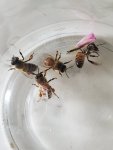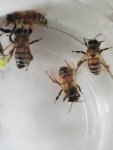SarahFair
Senior Member
I'm not yet set up for bees, but I've been toying with the idea and actually just started researching beekeeping.
In March of 2020 a huge swarm formed from one of the neighbors trees. A bee guy came out to see if he could catch the swarm, but they had already moved on by the time he got there. He believed they had swarmed due to over crowding, and that there was still a colony left in the tree.
The house now has new owners and I think they are looking to have that tree removed.
I'm not sure if the bees are still there, the entry of the hive is probably 30-40ft up the tree and would take active staring to see. Since I still dont really know the new neighbors and since the tree is literally next to their front porch and windows, I dont want to come off as "that" neighbor


Currently I'm letting the clover bloom in part of my back yard, as well as some other spring flowers, and the honey bees are all over it.
I saw a YouTube video of a guy that made a swarm bucket by just taking a 5 gal bucket, melting down some old combs, "painting" it on the lid, inside, and around the drilled opening of the bucket, then adding an attractant like lemon grass oil.
He's had success doing this, as well as other people commenting with their success.
I dont have any old combs, but he said you could possibly have some success by using yellow bees wax you'd get from the store.
My thought is, the bee's will get acquainted to this trap until the time the tree is taken down.
If they do end up freaking out and swarming they'll know of a viable option close by.

Has anyone tried something like this?
How long can you leave a swarm in a trap?
Do I even want to try and mess with feral bees?
I caught a few, put them in the freezer for a few minutes to slow them down and snap pictures, and released them back outside.
Any idea what type is running around this area?
I dont know the varieties well enough to tell them apart.



In March of 2020 a huge swarm formed from one of the neighbors trees. A bee guy came out to see if he could catch the swarm, but they had already moved on by the time he got there. He believed they had swarmed due to over crowding, and that there was still a colony left in the tree.
The house now has new owners and I think they are looking to have that tree removed.
I'm not sure if the bees are still there, the entry of the hive is probably 30-40ft up the tree and would take active staring to see. Since I still dont really know the new neighbors and since the tree is literally next to their front porch and windows, I dont want to come off as "that" neighbor


Currently I'm letting the clover bloom in part of my back yard, as well as some other spring flowers, and the honey bees are all over it.
I saw a YouTube video of a guy that made a swarm bucket by just taking a 5 gal bucket, melting down some old combs, "painting" it on the lid, inside, and around the drilled opening of the bucket, then adding an attractant like lemon grass oil.
He's had success doing this, as well as other people commenting with their success.
I dont have any old combs, but he said you could possibly have some success by using yellow bees wax you'd get from the store.
My thought is, the bee's will get acquainted to this trap until the time the tree is taken down.
If they do end up freaking out and swarming they'll know of a viable option close by.

Has anyone tried something like this?
How long can you leave a swarm in a trap?
Do I even want to try and mess with feral bees?
I caught a few, put them in the freezer for a few minutes to slow them down and snap pictures, and released them back outside.
Any idea what type is running around this area?
I dont know the varieties well enough to tell them apart.



